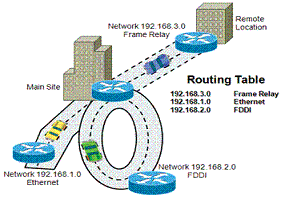Routing is the process of finding a path to a destination host and of moving information across an internetwork from a source to a destination. Along the way, at least one intermediate node typically is encountered. Routing is very complex in large networks because of the many potential intermediate destinations a packet might traverse before reaching its destination host.
A router is a device that forwards packets from one network to another and determines the optimal path along which network traffic should be forwarded. Routers forward packets from one network to another based on network layer information. Routers are occasionally called gateways (although this definition of gateway is becoming increasingly outdated).
Routers—Layer 3
A router is a more sophisticated device than a hub or a switch.. It determines the appropriate network path to send the packet along by keeping an up-to-date network topology in memory, its routing table.

A router keeps a table of network addresses and knows which path to take to get to each network.
Routers keep track of each other’s routes by alternately listening, and periodically sending, route information. When a router hears a routing update, it updates its routing table. Routing is often contrasted with bridging, which might seem to accomplish precisely the same thing to the causal observer. The primary difference between the two is that bridging occurs at Layer 2 (the data link layer) of the OSI reference model, whereas routing occurs at Layer 3 (the network layer). This distinction provides routing and bridging with different information to use in the process of moving information from source to destination, so that the two functions accomplish their tasks in different ways.
In addition, bridges can’t block a broadcast (where a data packet is sent to all nodes on a network). Broadcasts can consume a great deal of bandwidth. Routers are able to block broadcasts, so they provide security and assist in bandwidth control.
You might ask, if bridging is faster than routing, why do companies move from a bridged/switched network to a routed network?
There are many reasons, but LAN segmentation is a key reason. Also, routers increase scalability and control broadcast transmissions.
Where are Routers Used?
A router can perform LAN-to-LAN routing through its ability to route packet traffic from one network to another. It checks its router table entries to determine the best path to the destination network.
A router can perform LAN-to-WAN and remote access routing through its ability to route packet traffic from one network to another while handling different WAN services in between. Popular WAN service options include Integrated Services Digital Network, or ISDN, leased lines, Frame Relay, and X.25.
Let’s look at routing in more detail.
